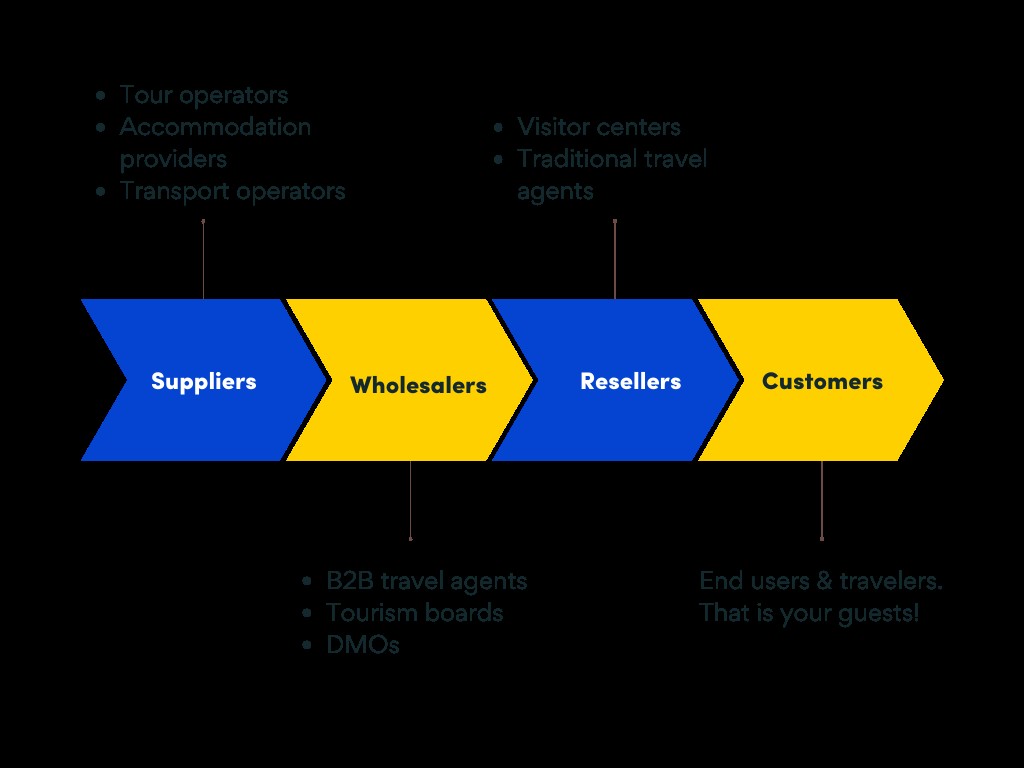Are you looking to boost your tourism business in Vietnam? Understanding what are direct and indirect tourism distribution channels is key to connecting with more customers and maximizing your reach. SIXT.VN offers expert guidance and services to help you navigate these channels effectively, ensuring a seamless and successful tourism strategy. Let’s explore tourism distribution, travel intermediaries, and effective distribution strategies.
1. What is a Tourism Distribution Channel?
A tourism distribution channel is how tourism products and services get from suppliers to consumers. It encompasses all the stakeholders and methods involved in making tourism products accessible. SIXT.VN acts as a bridge, connecting travelers with the best experiences Vietnam has to offer. According to the Vietnam National Administration of Tourism, effective distribution channels are crucial for attracting international tourists and boosting the local economy.
1.1. What are the Key Components of a Tourism Distribution Channel?
The key components of a tourism distribution channel include:
- Suppliers: These are the primary providers of tourism products such as hotels, airlines, and tour operators.
- Wholesalers: They create packages of travel products that retailers can sell.
- Resellers: These include travel agents and online travel agencies (OTAs) that sell directly to consumers.
- Consumers: The end-users of the tourism products and services.
Understanding these components is vital for optimizing your distribution strategy.
1.2. How Do Direct and Indirect Channels Differ?
Direct channels involve selling tourism products directly to consumers without intermediaries, while indirect channels use intermediaries such as travel agents and OTAs. SIXT.VN can help you manage both types of channels to maximize your market reach. According to a study by the United Nations World Tourism Organization (UNWTO), a balanced approach to direct and indirect channels can lead to increased bookings and revenue.
2. Why are Tourism Distribution Channels Important?
Tourism distribution channels are crucial for expanding market reach, increasing bookings, and optimizing marketing efforts. They connect tourism businesses with a broader customer base, reduce marketing costs, and improve customer satisfaction. SIXT.VN leverages its network and expertise to ensure your services are visible to the right audience.
2.1. How Do Distribution Channels Expand Market Reach?
Distribution channels expand market reach by connecting your business with various stakeholders in the tourism industry. Partnering with resellers and tourism platforms gives you access to a larger customer base that you might not reach through direct marketing alone. According to research from TripAdvisor, businesses that use multiple distribution channels see a significant increase in bookings.
2.2. What is the Role of Distribution Channels in Increasing Bookings?
Distribution channels play a vital role in increasing bookings by making your services more accessible to potential customers. By listing your products on popular OTAs and travel platforms, you increase the chances of being discovered by travelers planning their trips. SIXT.VN can help you optimize your listings and manage your inventory across multiple channels.
2.3. How Do Distribution Channels Optimize Marketing Efforts?
Distribution channels optimize marketing efforts by leveraging the marketing budgets and customer bases of existing platforms. Instead of investing heavily in direct marketing, you can partner with channels that already have a strong presence and a loyal customer base. This can lead to more efficient and cost-effective marketing.
 Tourism Distribution Channels Through Partnership
Tourism Distribution Channels Through Partnership
3. What are Direct Tourism Distribution Channels?
Direct tourism distribution channels involve selling tourism products directly to the end consumer without any intermediaries. This can include your website, direct bookings via a booking system, social media accounts, and even traditional methods like brochures and storefronts. SIXT.VN helps businesses optimize their direct channels for maximum impact.
3.1. What are Examples of Direct Tourism Distribution Channels?
Examples of direct tourism distribution channels include:
- Your Website: This is your digital storefront, where customers can learn about your offerings and book directly.
- Direct Bookings via a Booking System: Using a booking system allows customers to book and pay for your services online, without needing to contact you directly.
- Social Media Accounts: Social media platforms can be used to promote your services and engage with potential customers.
- Email Marketing: Sending personalized email messages to previous and potential customers.
- Brochures and Flyers: Traditional marketing materials can still be effective, especially in tourist hotspots.
- Storefront: Having a physical location where customers can walk in and book your services.
3.2. What are the Advantages of Direct Tourism Distribution Channels?
The advantages of direct tourism distribution channels include:
- Higher Profit Margins: You don’t have to pay commissions to intermediaries.
- Direct Customer Relationships: You can build relationships with your customers and gather feedback directly.
- Full Control Over Branding: You have complete control over how your brand is presented.
- Flexibility: You can quickly adapt your offerings and pricing based on customer demand.
3.3. What are the Disadvantages of Direct Tourism Distribution Channels?
The disadvantages of direct tourism distribution channels include:
- Higher Marketing Costs: You have to invest in marketing to attract customers.
- Time-Consuming: Managing direct bookings and customer inquiries can be time-consuming.
- Limited Reach: You may not be able to reach as many customers as you would through indirect channels.
- Requires Expertise: You need to have expertise in marketing, sales, and customer service.
4. What are Indirect Tourism Distribution Channels?
Indirect tourism distribution channels involve using intermediaries to sell tourism products to the end consumer. These intermediaries can include travel agents, online travel agencies (OTAs), wholesalers, and destination management organizations (DMOs). SIXT.VN can help you navigate these channels effectively.
4.1. What are Examples of Indirect Tourism Distribution Channels?
Examples of indirect tourism distribution channels include:
- Travel Agents: Traditional travel agents create personalized travel packages for their clients.
- Online Travel Agencies (OTAs): Platforms like Expedia, Booking.com, and TripAdvisor allow customers to book flights, hotels, and tours online.
- Wholesalers: They develop packages of travel products for retailers to sell.
- Destination Management Organizations (DMOs): Government tourism boards or tourism authorities that promote tourism in a specific destination.
- Global Distribution Systems (GDSs): Used by retailers such as OTAs to easily see an inventory of availability from tourism operators.
4.2. What are the Advantages of Indirect Tourism Distribution Channels?
The advantages of indirect tourism distribution channels include:
- Broader Reach: You can reach a larger customer base through the extensive networks of intermediaries.
- Lower Marketing Costs: Intermediaries invest in marketing, reducing your marketing expenses.
- Increased Bookings: Being listed on popular platforms can lead to a significant increase in bookings.
- Access to Expertise: Intermediaries have expertise in marketing, sales, and customer service.
4.3. What are the Disadvantages of Indirect Tourism Distribution Channels?
The disadvantages of indirect tourism distribution channels include:
- Lower Profit Margins: You have to pay commissions to intermediaries.
- Less Control Over Branding: You have less control over how your brand is presented.
- Dependence on Intermediaries: You are dependent on intermediaries to sell your products.
- Complex Management: Managing relationships with multiple intermediaries can be complex.
 The Chain of Tourism Distribution
The Chain of Tourism Distribution
5. How to Choose the Right Tourism Distribution Channels?
Choosing the right tourism distribution channels requires understanding your target market, researching available channels, evaluating costs and benefits, and tracking performance. SIXT.VN offers expert advice and tools to help you make informed decisions.
5.1. How to Identify Your Target Market?
Identifying your target market involves understanding demographics such as age, country of origin, the number of travelers in a party, and the number of children arriving. This information can help you determine which channels are most effective for reaching your customers. According to the General Statistics Office of Vietnam, understanding traveler demographics is crucial for tailoring your marketing efforts.
5.2. How to Research Available Tourism Distribution Channels?
Researching available channels involves identifying which platforms and businesses align with your values and can effectively promote your services. It’s essential to understand the reputation of your potential strategic partners and make informed decisions based on what will work for your business.
5.3. How to Evaluate the Costs and Benefits of Different Channels?
Evaluating costs and benefits involves understanding the pricing models of different platforms and distribution channels. Some may charge a flat fee for promotional services, others may purchase and resell your services, while others may charge a fee when you receive a booking. It’s essential to understand what level of return you can expect.
5.4. How to Track the Performance of Your Distribution Channels?
Tracking performance involves monitoring the results you achieve through each channel and comparing them to the costs of using those channels. By understanding the performance of your partnerships, you can eliminate ineffective channels and double down on your marketing efforts, thus cutting your costs.
6. What Role Do Online Travel Agencies (OTAs) Play?
Online Travel Agencies (OTAs) have become dominant players in the tourism industry, providing a centralized platform for users to plan, book, and pay for personalized travel plans. They offer a range of tourism products such as airline tickets, hotel bookings, car rentals, and local experiences, making the booking process convenient and intuitive.
6.1. What are the Benefits of Using OTAs?
The benefits of using OTAs include:
- Wide Reach: OTAs have a large customer base and can help you reach a global audience.
- Convenience: Customers can book multiple travel services in one place.
- Marketing Support: OTAs invest in marketing, driving traffic to your listings.
- Credibility: Being listed on a reputable OTA can increase customer trust.
6.2. What are the Drawbacks of Using OTAs?
The drawbacks of using OTAs include:
- Commission Fees: OTAs charge commission fees, reducing your profit margins.
- Loss of Control: You have less control over the customer experience.
- Competition: You are competing with many other businesses on the same platform.
- Dependence: You become dependent on the OTA for bookings.
6.3. How to Optimize Your Listings on OTAs?
To optimize your listings on OTAs:
- Use High-Quality Photos: Showcase your property or services with attractive, professional photos.
- Write Compelling Descriptions: Highlight the unique features and benefits of your offerings.
- Offer Competitive Pricing: Research your competitors and price your services competitively.
- Respond to Reviews: Respond promptly and professionally to customer reviews.
- Keep Your Availability Updated: Ensure your availability is always accurate to avoid overbookings.
7. How Can Mobile Channels Enhance Distribution?
Mobile channels, such as apps, provide another avenue to promote and sell tourism products. Airlines, hotels, and other major suppliers have developed apps to improve customer loyalty and engagement. Other forms of mobile marketing include SMS marketing, mobile advertising, and cold calling.
7.1. What are the Advantages of Using Mobile Channels?
The advantages of using mobile channels include:
- Direct Communication: You can communicate directly with customers through push notifications and SMS messages.
- Personalization: You can personalize offers and recommendations based on customer preferences.
- Convenience: Customers can book your services on the go, anytime, anywhere.
- Loyalty Programs: You can reward loyal customers with exclusive offers and discounts.
7.2. What are Effective Mobile Marketing Strategies?
Effective mobile marketing strategies include:
- Developing a User-Friendly App: Make sure your app is easy to use and provides value to customers.
- Sending Personalized Push Notifications: Send targeted messages based on customer interests and behavior.
- Offering Mobile-Exclusive Deals: Encourage customers to book through your app by offering exclusive deals.
- Using Location-Based Marketing: Target customers based on their location to promote nearby attractions and services.
- Implementing SMS Marketing: Send text messages with special offers and promotions.
 Travel Distribution Services
Travel Distribution Services
8. How Does Technology Aid Distribution Channel Management?
Technology plays a crucial role in managing distribution channels, with tools like channel managers simplifying the process of negotiating agreements, managing inventory, rates, and commissions with a range of resellers. SIXT.VN utilizes cutting-edge technology to ensure seamless management.
8.1. What is a Channel Manager?
A channel manager is a software solution that allows you to manage your inventory and rates across multiple distribution channels from a single dashboard. This eliminates the risk of overbookings and ensures that your information is always up-to-date.
8.2. What are the Benefits of Using a Channel Manager?
The benefits of using a channel manager include:
- Real-Time Updates: Automatically updates your inventory and rates across all channels.
- Reduced Overbookings: Eliminates the risk of overbookings by syncing availability in real-time.
- Time Savings: Saves time by managing all your channels from one place.
- Increased Revenue: Helps you maximize revenue by optimizing your pricing and availability.
8.3. What Features to Look for in a Channel Manager?
Features to look for in a channel manager include:
- Integration with Multiple Channels: Ensure the channel manager integrates with the OTAs and other channels you use.
- Real-Time Syncing: Look for real-time syncing of inventory and rates.
- User-Friendly Interface: Choose a channel manager with an easy-to-use interface.
- Reporting and Analytics: Look for reporting and analytics features to track your performance.
- Customer Support: Ensure the channel manager offers reliable customer support.
9. What are the Emerging Trends in Tourism Distribution?
Emerging trends in tourism distribution include:
- Personalization: Customers expect personalized experiences and offers.
- Mobile-First Approach: More and more customers are using mobile devices to plan and book their trips.
- AI and Chatbots: AI-powered chatbots are being used to provide customer support and assist with bookings.
- Sustainability: Customers are increasingly interested in sustainable travel options.
- Experiential Travel: Customers are looking for unique and authentic experiences.
9.1. How to Incorporate Personalization into Your Distribution Strategy?
To incorporate personalization into your distribution strategy:
- Collect Customer Data: Gather data on customer preferences and behavior.
- Segment Your Audience: Segment your audience based on their interests and needs.
- Offer Personalized Recommendations: Recommend products and services based on customer preferences.
- Customize Your Marketing Messages: Customize your marketing messages to resonate with different segments of your audience.
- Provide Personalized Customer Service: Offer personalized customer service to address individual needs and concerns.
9.2. How to Leverage Mobile Technology for Better Distribution?
To leverage mobile technology for better distribution:
- Develop a Mobile App: Create a user-friendly app that allows customers to book your services on the go.
- Optimize Your Website for Mobile: Ensure your website is mobile-friendly and easy to navigate on small screens.
- Use Location-Based Marketing: Target customers based on their location to promote nearby attractions and services.
- Offer Mobile-Exclusive Deals: Encourage customers to book through their mobile devices by offering exclusive deals.
- Implement SMS Marketing: Send text messages with special offers and promotions.
10. Frequently Asked Questions (FAQs) about Tourism Distribution Channels
10.1. What is the difference between a direct and indirect distribution channel in tourism?
A direct distribution channel involves selling tourism products directly to the end consumer without any intermediaries, while an indirect distribution channel uses intermediaries such as travel agents and OTAs.
10.2. Why are distribution channels important for tourism businesses?
Distribution channels are crucial for expanding market reach, increasing bookings, and optimizing marketing efforts. They connect tourism businesses with a broader customer base, reduce marketing costs, and improve customer satisfaction.
10.3. What are some examples of direct tourism distribution channels?
Examples include your website, direct bookings via a booking system, social media accounts, email marketing, brochures and flyers, and a storefront.
10.4. What are some examples of indirect tourism distribution channels?
Examples include travel agents, online travel agencies (OTAs), wholesalers, destination management organizations (DMOs), and global distribution systems (GDSs).
10.5. How can I choose the right tourism distribution channels for my business?
Consider factors such as your target market, available channels, costs and benefits, and performance tracking to choose the most effective channels.
10.6. What role do Online Travel Agencies (OTAs) play in tourism distribution?
OTAs provide a centralized platform for users to plan, book, and pay for personalized travel plans, offering a range of tourism products such as airline tickets, hotel bookings, car rentals, and local experiences.
10.7. How can mobile channels enhance tourism distribution?
Mobile channels, such as apps, provide another avenue to promote and sell tourism products, allowing for direct communication, personalization, and convenience for customers.
10.8. What is a channel manager, and how can it help my business?
A channel manager is a software solution that allows you to manage your inventory and rates across multiple distribution channels from a single dashboard, reducing overbookings and saving time.
10.9. What are some emerging trends in tourism distribution?
Emerging trends include personalization, a mobile-first approach, AI and chatbots, sustainability, and experiential travel.
10.10. How can SIXT.VN help me with my tourism distribution strategy?
SIXT.VN offers expert guidance and services to help you navigate direct and indirect channels, optimize your listings, and leverage technology for seamless distribution management.
Ready to take your tourism business to the next level? Contact SIXT.VN today for a consultation and discover how we can help you optimize your distribution strategy and reach more customers. Visit our website or call +84 986 244 358 to learn more. Address: 260 Cau Giay, Hanoi, Vietnam. Let SIXT.VN be your partner in success.



